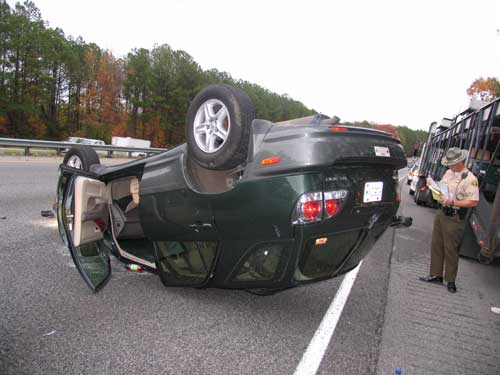 By Bob Ciminel November 20, 2006
As I dozed off in the passenger seat, everything seemed normal. A short distance north of Exit 193, I heard my wife say, "Oh, Bob!" and woke up to see the car moving toward the guard rail. And then, at 75 mph, we hit the guard rail and I thought, "This is going to be expensive!" as the left front fender crumpled and the headlight and parking light assembly flew off. I didn't realize that it was going to be a lot worse than expensive. As the car bounced off the guard rail, my wife overcorrected and the car lurched into the middle lane, and then began fishtailing. One second we were heading for the ditch at the side of the highway, and the next second we would be heading back toward the guard rail. The car was completely out of control. And that's when I thought, "We're going to die!" 
I looked at my wife and said, "I'm alright. Are you alright?" As we tried to orient ourselves and assess our situation, I immediately worried about fire - we had a full tank of gas. But the engine was off and I could not smell gasoline, so I thought, "I'll just wait and hope someone comes along soon and helps us out." My wife said she could not release her seat belt. I couldn't reach the release button either, but someone opened her door - a young black man she recalled later - and asked if he could help. He told her he would have to lift her to release the seat belt, and was that okay with her. That was a no-brainer, so he unhooked her and helped her crawl out of the driver's side door. I was able to release my seat belt and drop the six or so inches to the roof, and then I crawled out the driver's side. The bystanders were amazed that we were unhurt. I was amazed that we were alive. The car was totaled. We walked away from what could have been a fatal accident because we had our seat belts fastened - the airbags never actuated. We were unhurt because we stayed in the car throughout the crash. Had either of us been ejected, as so often happens in rollover accidents, one of us would be attending a funeral this week instead of the annual oyster roast on St. Simons Island, which was our destination. (We were able to rent a car and continue our trip.) And so, Dear Readers, as we approach this Thanksgiving Holiday my wife and I have much to be thankful for and we pray that those of you who travel our nation's highways this holiday remember to buckle up. Sure, seat belts can be uncomfortable and a pain in the neck and you hear all those urban legends about people being trapped in their seat belts after a crash. Well, here it is, straight from the horse's mouth at Snopes.com: "The false belief that it's safer not to wear a seat belt in case the vehicle catches fire persists despite the mountain of evidence countering it. Death by incineration or drowning accounts for less than one-tenth of one percent of motor-vehicle-related traumas. Most passengers who are ejected from vehicles die, and the majority of them are thrown through the windshield. The chances of injury from hitting the pavement, a fixed object, or a moving vehicle (including your own) are also much greater if you are not wearing a seat belt. The National Highway Traffic Safety Administration says: Most crash fatalities result
from the force of impact or from being thrown from the vehicle,
not from being trapped. All studies show you are much more likely
to survive a crash if you are buckled in. Ejected occupants are
four times as likely to be killed as those who remain inside.
On the Web:
He assumes informed readers will be able to tell the difference. Bob lives in Roswell, Georgia, and works for the Institute of Nuclear Power Operations. He is also a conductor on the Blue Ridge Scenic Railway. Contact Bob at ciminel@sitnews.us
|